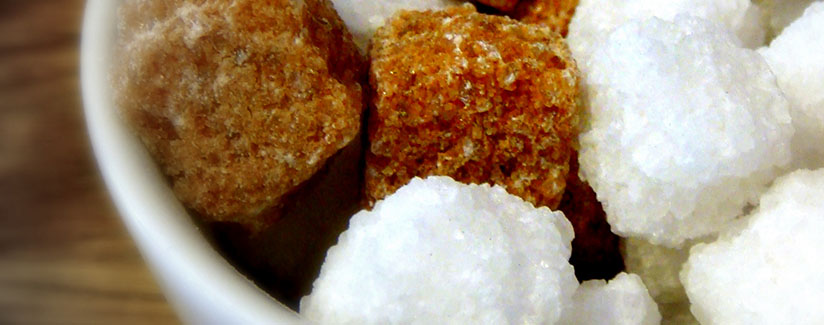
Of Mice and Men…And Sugar
01/15/2015
A new study scheduled for publication in the March 2015 issue of The Journal of Nutrition claims that fructose is more toxic than table sugar when fed to mice in doses proportional to human consumption. University of Utah biology professor and senior study author Wayne Potts said, “This is the most robust study showing there is a difference between high-fructose corn syrup and table sugar at human-relevant doses.” We wanted to know more about what that may mean for human health, so we enlisted the help of Carolyn O’Neil, MS, RD; Ruth MacDonald, PhD, RD, Chair and Professor of the Department of Food Science and Human Nutrition at Iowa State University; and Connie Diekman, M.Ed, RD, Director of University Nutrition at Washington University.
The new study from the University of Utah compared toxicity levels of high-fructose corn syrup (HFCS) and table sugar in mice. Before delving more into the study, can you first explain the difference(s) between HFCS and table sugar?
Carolyn O’Neil:
I’ve always thought that high-fructose corn syrup is actually misnamed, so it causes confusion right off the bat. Table sugar and HFCS are nearly identical in composition, have the same number of calories – just as most carbohydrates, with four calories per gram. That’s why The Academy of Nutrition and Dietetics Hot Topics paper on High-Fructose Corn Syrup states that once absorbed into the bloodstream, (the two) are indistinguishable.
Connie Diekman:
HFCS is similar to table sugar in that it is a combination of two smaller sugar molecules, monosaccharides, to make a sweet product for use in a variety of foods. Table sugar, also called sucrose, and HFCS are both a combination of fructose and glucose – the difference being table sugar is 50% fructose and 50% glucose and HFCS is 55% fructose and 45% glucose. The sweeter taste of fructose often means that less sweetener is used when food is sweetened with HFCS.
Ruth MacDonald:
HFCS is derived from corn syrup, which contains mainly the monosaccharide glucose. The corn syrup is treated with an enzyme, which converts some of the glucose to fructose. This is done to make the corn syrup taste sweeter than it would if it just contained glucose. Table sugar is derived from sugar beets or cane and contains roughly the same ratio of glucose and fructose found in HFCS.
The researchers used doses of sugar proportional to what humans eat – how significant is that on the study’s findings and the impact on human health?
Ruth MacDonald:
The study was done in mice that were fed the same diets over long periods of time. The level of 25% HFCS is at the high level for most people and not commonly consumed at that dose every day throughout the life span. It is hard to develop animal diet models that mimic human dietary patterns across life.
Connie Diekman:
The fact that the amount of sugar consumed was comparable to what humans consume is important but this was a mouse study, and how mice metabolize food is different than humans. So the outcome should be viewed as interesting and worthy of more study but not conclusive to its impact on humans.
Carolyn O’Neil:
I can’t really comment on the study’s research design, but I liked the fact that researcher and study author James Ruff says in a press release from the University of Utah, “Our previous work and plenty of other studies have shown that added sugar in general is bad for your health. So first, reduce added sugar across the board.” The U.S. Dietary Guidelines, which are based on current nutrition science, suggest we all limit added sugar in our diets to keep calories in check for healthy weight management. Of course, that doesn’t mean you can’t enjoy a slice of pie or a cold cola on occasion. Sweet ‘splurge’ foods can fit into a healthy diet in moderation. MyPlate is a great resource to develop a meal plan for children and adults, and provides guidance on variety and portion sizes for all foods to enjoy including fruits, vegetables, whole grains, proteins and dairy foods.
The study showed that the fructose-glucose mixture found in HFCS was more toxic than table sugar, which reduced the production and lifespan of female rodents, but found no differences in male rodents fed either a fructose-glucose diet or a sucrose diet. Does this mean HFCS has the same effect on women’s reproductive systems and lifespans? And does this mean it’s OK for men to consume sugar or HFCS?
Connie Diekman:
Extrapolating the outcomes of this study to any recommendations for human consumption would be difficult due to the limitations (it is a mouse study, the quantity of carbohydrates was 63% of calories, and the reference for fructose to glucose intake is from a study that is now 10 years old). The best interpretation of these outcomes would be that a high intake of sugar is not healthful. As a registered dietitian, that is a message I have given for many years, and the Dietary Guidelines for Americans have also encouraged added sugar intake (all types) be limited.
Ruth MacDonald:
The study lacks any toxicological assessment of the animals, so the cause of death is not explained. This makes it nearly impossible to determine if the death rate was associated with the metabolic effects of the diet or to something completely unrelated. Reproductive behavior in mice is very different than in people. This study allowed male mice to compete for females, and it is well documented that many factors affect mating behavior. Mice are not people, of course, and so making a quantum leap from this study to make recommendations to humans would not be justified.
Carolyn O’Neil:
Nutrition research is an evolving science and it’s good that researchers are asking questions about the safety of so many ingredients in our food supply. Animal studies are important to answer metabolic questions specific to a particular animal model (in this case mice) and do give scientists clues that might lead to more relevant human studies. But you can’t immediately extrapolate animal study findings to create health recommendations for humans because of the physiological and psychological differences between humans and rodents.
What’s the take-away of this study for people?
Connie Diekman:
For me as an RD, the take-away is that we need more research to assess what health impacts added sugars have on the body. For my clients, the take-away is that added sugars – all forms – should not be first choice for calories, and that foods represented in MyPlate should be first choice, with added sugars included if calories allow.
Carolyn O’Neil:
The take-away is that we will continue to see and hear blips of news reports sharing the latest results on the health advantages and disadvantages of various food ingredients. As a registered dietitian, I see no reason to believe at this point that the composition of high-fructose corn syrup is somehow less healthy than table sugar. I do think that the sugar calories in over-sweetened foods and beverages can contribute to being overweight and to obesity. So, I advise limiting the use of all sweeteners including honey and agave, which contain fructose, too, by the way.
Science Note: The study researchers point out that HFCS contains fructose and glucose as two separate monosaccharides and that table sugar or sucrose is a combination of fructose and glucose joined together molecularly as a disaccharide. They propose that this is why the two compounds may be metabolized differently. But, according to the FDA, “Once one eats [sucrose], stomach acid and gut enzymes rapidly break down this chemical bond.” Source: U.S. Food and Drug Administration – High Fructose Corn Syrup: Questions and Answers
Ruth MacDonald:
Scientific research is important and new approaches and ideas are needed to carefully define the role of food and health. One study should never be considered the final answer, however. This study is interesting and adds to our body of science related to food and health, but it should not be used to define the effect of HFCS or sugar on people. As nutritionists have continually promoted, food should be enjoyed in moderation.
“Sugar Cubes” by Kurtis Garbutt is licensed under CC BY 2.0




























